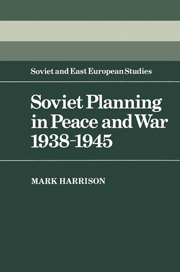Book contents
- Frontmatter
- Contents
- Dedication
- Preface
- Acknowledgements
- 1 ECONOMIC PLANNING AND THE SEARCH FOR BALANCE
- 2 THE COMING OF WAR: PLANS AND REALITIES IN 1941
- 3 THE SOVIET PRODUCTIVE EFFORT
- 4 THE SEARCH FOR ECONOMIC BALANCE IN WARTIME
- 5 SOVIET LESSONS FROM WORLD WAR II
- APPENDICES
- 1 Soviet arms production 1930–45
- 2 Soviet heavy industry output 1928–45
- 3 Soviet arms balances 1941–5
- 4 Composition of the USSR Sovnarkom 1938–45
- 5 Abbreviations and technical terms
- Bibliography
- Index
5 - Abbreviations and technical terms
Published online by Cambridge University Press: 29 October 2009
- Frontmatter
- Contents
- Dedication
- Preface
- Acknowledgements
- 1 ECONOMIC PLANNING AND THE SEARCH FOR BALANCE
- 2 THE COMING OF WAR: PLANS AND REALITIES IN 1941
- 3 THE SOVIET PRODUCTIVE EFFORT
- 4 THE SEARCH FOR ECONOMIC BALANCE IN WARTIME
- 5 SOVIET LESSONS FROM WORLD WAR II
- APPENDICES
- 1 Soviet arms production 1930–45
- 2 Soviet heavy industry output 1928–45
- 3 Soviet arms balances 1941–5
- 4 Composition of the USSR Sovnarkom 1938–45
- 5 Abbreviations and technical terms
- Bibliography
- Index
Summary
‘A’ AND ‘B’ GROUP INDUSTRIES
Industries of group ‘A’ produce the means of production or industrial goods, and industries of group ‘B’ produce the means of consumption. This is a classification of industry by product utilisation, as distinct from the division of industries into heavy and light industry (q.v.), which is based on the production technology of the industrial branch. For example private cars are produced in the engineering industry (a heavy industry) but are classified as means of consumption (group ‘B’).
ARMS INDUSTRIES
Before the war the Soviet arms industries were organised under commissariats (q.v.) for aircraft, armament, ammunition and shipbuilding. These industries also produced some civilian goods, and some military goods (e.g. armoured vehicles, aircraft components) were produced in the nominally civilian engineering industry. During the war new commissariats were created to cover the tank industry and also mortar armament. The arms industries are normally included under group ‘A’ industry (q.v.), but some Soviet economists believe that they should be classified separately as industries producing the means of destruction.
BALANCE
In Soviet usage the word balance carries many different meanings, but they all have a common core. Among the English equivalents are words like equilibrium, proportion (as in ‘well-proportioned’) and harmony. The main alternative uses are as follows. First, a material balance (e.g. the oil balance or the balance of machine tools) refers to the equilibrium or lack of it between supply and demand for a particular good; this is a microeconomic balance.
- Type
- Chapter
- Information
- Soviet Planning in Peace and War, 1938–1945 , pp. 287 - 293Publisher: Cambridge University PressPrint publication year: 1985



